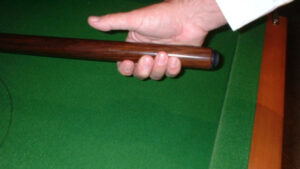Learn to Play Eight Ball Gripping the Cue
Learn to Play Eight Ball Gripping the Cue. The seemingly mysterious and fascinating effects obtained by a skilled professional stem from his hold on the cue. Rarely do spectators watch the hand that holds the cue, but rather the end that propels the cue ball into action. Not that much would be seen anyway, so quick and slight are the squeezes and little flicks of the wrist that spin the ball on its way. So much do the fingers holding the butt and the wrist work in harmony to get the desired effects that I find it hard to separate them in describing their respective functions.
The hold must be soft but firm, working in conjunction with a supple wrist, if and when required. The correct cue hold is made by holding the butt softly with all the fingers, keeping the little finger in constant slight pressure, gradually easing off on the remaining fingers so that the forefinger is merely a cradle. This way you will find that your wrist will be a little more controlled in its back and forth motion for the various screw and side effect shots.
There is a general tendency to hold the cue with the forefinger and thumb far too severely which cramps cue delivery, particularly the follow-through. The thumb merely acts as the door to the hand, closing it to keep the butt in position without any pressure.
The wrist needs to move forward with the forearm in delivery adding that extra thrust. This flick in the delivery can be varied with great control when mastered and the effects can be seen to advantage in slow screw and very deep-powered screw shots. To the experts, and the not so expert, these little movements are accepted and probably never thought about. However to the not so lucky and believe me there are plenty of them explanation so often brings results much sooner. Learn to Play Eight Ball Gripping the Cue
Power From the Wrist:
In order to play a really deep screw shot the cue hold must be momentarily transferred to the forefinger and the thumb allowing the little finger and hand to open on the last backward delivery before striking. The hold returns to the back of the hand on the forward stroke, which then produces far more thrust from the wrist.

learn to play eight ball gripping the cue
The cue is virtually wedged into the back of the hand at the end of the stroke – it is not suddenly gripped tightly as this can create an early snatch effect and ruin the stroke. With this additional power combined with a smooth follow – through, the cue ball can really be made to fizz in a backward spin as it is propelled forward until it touches the object ball. It is when you get a full and accurate contact that your screw effect is greatest. Have you ever in your younger days, thrown a hoop forward with a flick of the wrist and tried to make it return to you?
Well that is the sort of action required for screwing a ball. Learn to Play Eight Ball Gripping the Cue
The straighter you can keep your wrist in line with your forearm the better your chance of keeping a supple wrist with good control and accurate cue ball striking. I know from experience many players seem to have to cock the wrist out of line and bad habits are hard to break. At all costs at least try to soften the hold otherwise your wrist will remain too tight and touch is lost to a very large degree.
In order to emphasise the need for a relaxed hold I have used the word ‘hold’ and not ‘grip’ throughout this section. Grip could mislead you into thinking that contact with the cue butt must at some point be tight. The billiard player is renowned for the general sweetness and softness of his play, indeed, the game demands it. While eight ball may call for many screw, spin, and stun shots, these are not achieved any easier or better by adopting a different hold from that recommended.
Learn to Play Eight Ball Gripping the Cue
More details are available here Accreditation and the AEBF is the National Sporting Organisation for EightBall Development.
Learn to Play Eight Ball Gripping the Cue